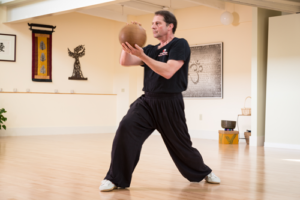Taiji Ball Qigong
 Taiji ball is a a fun and energetic practice that uses a ball to enhance the physical structure of your body. Like all Qigong practices, Taiji Ball aims to develop coordination between the mind, body and breathing. Taiji Ball comes from Martial Qigong and has been used for centuries to develop smooth body motion. Whether you practice it gently or vigorously, it's great exercise and lots of fun. And if you practice the Taiji form, this class will greatly enhance your skill and understanding of the movements. Suitable for all ages and fitness levels.
Taiji ball is a a fun and energetic practice that uses a ball to enhance the physical structure of your body. Like all Qigong practices, Taiji Ball aims to develop coordination between the mind, body and breathing. Taiji Ball comes from Martial Qigong and has been used for centuries to develop smooth body motion. Whether you practice it gently or vigorously, it's great exercise and lots of fun. And if you practice the Taiji form, this class will greatly enhance your skill and understanding of the movements. Suitable for all ages and fitness levels.
Skills taught in this class:
This course will teach you the basic movement patterns of ball handling, ball travel orientation, body travel orientation and stepping.
- Internal Qi development (no ball) The movement patterns trained without a ball train the basics of connected body movement. When no ball is involved, you will learn to feel your body and locate areas and movements that are restricted. This feeling can be used to focus attention and expand your range of motion in key areas.
- External Jing development (with ball) When the ball is used, it creates an external force. You will learn to manage this incoming and outgoing force, reacting with your entire body. Relatively weak individual limbs can be supported by whole body motions, making them significantly stronger and more effective.
- Body, breathing & mind development (solo practice) This is the most challenging aspect of Taiji Ball training. It is easy to wing a ball around in circles, but supporting each movement with carefully coordinated breathing, whole body motion and mental focus is the practice of a lifetime. In this class, you will learn the basic foundation of this practice for on-going personal development.
- Feeling & hand sensitivity development (on a surface). This part of the Taiji Ball practice is done with the ball on a surface and develops sensitivity, the skills of “sticking” and manipulation.
- Balance & focus development (on bricks). Doing the Taiji Ball movements on bricks develops the practitioner’s root and stability. This practice will be introduced and described in the class.
Miss the beginning of this session?
No worries; jump in anytime and enjoy the benefits!

Sorry, the comment form is closed at this time.